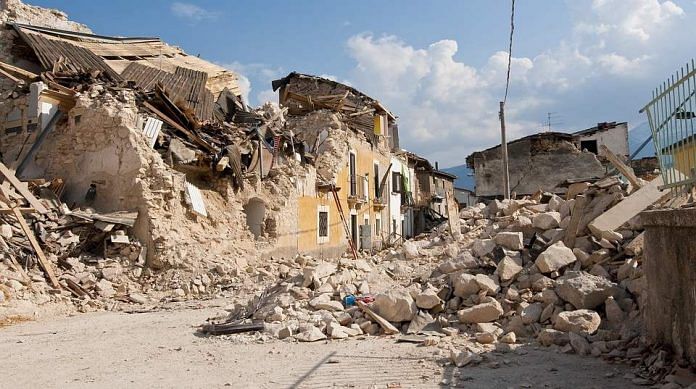New Delhi: With nearly 13 earthquakes jolting the Delhi-NCR region in two months, there have been apprehensions if it is a prelude to a big temblor, but experts say there is nothing unusual in this seismic activity.
Though it is not possible to predict quakes, a proper disaster management plan should be in place to deal with any emergency, they stressed.
The Delhi-NCR region is very peculiar with regard to seismic activities. It has several faultlines that generate earthquakes, but it also feels the impact of quakes that are epicentred as far as the Hindukush mountains in Afghanistan and even in Nepal.
Delhi witnessed a major earthquake in 1720 measuring 6.5. The last major quake in the region was near Bulandshahr in 1956 measuring 6.7, according to A K Shukla, who was the head of the Centre for Semiology and Earthquake Risk Evaluation Centre of the India Meteorology Department which was later brought under the newly formed National Centre for Seismology.
Shukla said the recent quakes are not an unusual phenomenon as the Delhi NCR region has several faultlines like the Mahendragarh-Dehradun faultine. There are faults at Mathura, Moradabad and Sohna.
All the recent 13 quakes recorded in the Delhi-NCR region were of low to medium intensity April 12 – Delhi (3.5); April 13-Delhi (2.7); April 16 Delhi (2); May 3 Delhi (3); May 6 Faridabad (2.3), May 10 Delhi (3.4); May 15 Delhi (2.2), May 28 Faridabad (2.5); May 29 Rohtak (4.5 and 2.9); June 1 Rohtak (1.8 and 3) and June 3 – Faridabad (3.2).
Of these 13, only the quake occurred at Rohtak was above 4 which falls under the medium intensity quake.
C P Rajendran, professor of Geodynamics at the Jawaharlal Nehru Centre for Advanced Scientific Research, Bengaluru, said Delhi has not witnessed any quake above 4.5 magnitude so far.
There is a very little possibility of having a major earthquake in the Delhi-NCR, a region with very high population density, he said.
Also read: How we discovered slow earthquakes that happen over weeks or even months
Earthquakes are not new to the Delhi-NCR because of its several faultlines. If one observes the earthquake pattern since last two and half months, the highest magnitude was 4.5 recorded on May 29 (Rohtak). Since then it has reduced, he said.
“We don’t have the faultlines in Delhi that stretch for hundreds of kilometres, like the way we have in Himalayas which is known for its high seismic activities. There are local faultlines and are bound to release the stress resulting in quakes,” Rajendran said.
Due to the fault systems around Delhi, the city could get an earthquake of magnitude around 6 to 6.5, but this only shows capability of the local system, Shukla said.
“It does not mean that such a quake will occur immediately as there is no scientific technique to predict earthquake, he said.
Shukla who was part of the team that conducted seismic microzonation of the city said 30 per cent of Delhi falls under Zone V, while the rest is under Zone IV.
According to the macro seismic zoning map of entire India, the Bureau of Indian Standards has classified the entire country into four major groups Zone V (high intensity) to Zone II (low intensity).
The recent quakes are a warning, but there is no technology to predict earthquakes. We need to have a mitigation plan like having structures that can withstand tremors. Delhi also feels tremors whenever quakes occur in the Himalayas, he added.
IIT Guwahati Director T G Sitharam said the nearest point from the Main Boundary Thrust (MBT) to Delhi is at around 200 kilometres.
But there is a possibility of a bigger earthquake of magnitude seven. Nothing can be ruled out. No one can say when will that happen, said Sitharam, who was part of the team that reviewed the NCS’ efforts to conduct seismic microzonation of Delhi.
He said Delhi lies on the Indo-Gangetic belt which has sediments. This amplifies the earthquake motion and thus its impact.
So, if any quake occurs in Himalayas or even the Hindukush, the impact could be felt in Delhi-NCR. He also cited the 2015 Nepal earthquake which was felt across the Indo-Gangetic belt including Delhi, he said.
He emphasised on sensitising people and taking precautionary measures.
There is a strong need to prepare the community for earthquake disaster. Earthquakes don’t kill, it is the buildings that do. Thus, awareness on earthquake resistant design and earthquake preparedness is important to the community at large and it is critical to prepare the community for an eventuality, said Sitharam, who is also the president of the Indian Society of Earthquake technology.
J L Gautam, head (operations) of the NCS, also stressed the need to have proper structures that can withstand tremors.
We cannot predict quakes, but we can have a proper disaster management plan in place, Gautam said.
Also read: Scientists discover earthquake-like phenomenon called stormquakes that can pound sea floor



